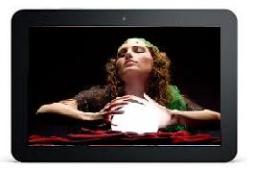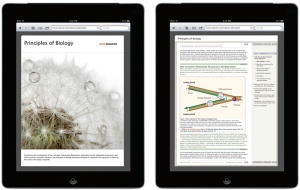The etextbook in 2018 will be dramatically different than the etextbook of today. It will be coupled to an app that will provide you with Content as a Service (CaaS). CaaS will include many of the following features (and more that have yet to be imagined):
- Multimedia
- Simulations
- Educational Games
- Animations
- Pre- and post-tests
- Formative and Summative Quizzes
- Adaptive testing
- Networked Social Learning
- Study groups
- Analytic Datasets
- Virtual and Flipped classes
- Communities of Learning and Practice
- Virtual classes.
It will be designed to make learning easier and more effective. It will replace the old print (and even current online) early prototype etextbook that still uses content as the product. By 2018, you will be purchasing the services which the CaaS app will provide. Dream with me a moment …
I am sitting at my desk in the near future, the year 2018. My Ecology etextbook is on my tablet and my elearning app helping me take notes. I read the following: “The biosphere is interconnected with three other spheres of the physical environment: the lithosphere, the hydrosphere, and the atmosphere.” I press the ASK THE EXPERT button and an email form pops up. “What” I write “does the term Gaia have to do with all the spheres?” The answer will probably be in my inbox before I go to sleep. I watch the animation of clouds forming and rain falling and plants growing. I skip the I Dig the Earth game and decide to test myself to see if I’m getting it.
So I touch the TEST ME button and a menu comes down asking what kind of test do I want? I say Chapter, and a test of the chapter appears. I could have asked for Page, Chapters or Book. I answer the questions, get most right, and the ones I missed are automatically turned into flashcards. I skim all the sentences I highlighted when I was reading, check the notes my friends sent about the book, answer a few questions they asked, and bookmark my place. I remember to place a yellow sticky note on the front to find my reading glasses although enlarging the type was no problem. I check the times of my remaining biology courses that week, and make sure there are no tests coming up. Taking a break from studying, I switch from the etextbook to an old Big Bang Theory TV episode I missed.
Nice fantasy? Not at all. The etextbook of the future is all about the idea of Content as a Service (CaaS). Textbooks in the not-too-distant past were a product. You wrote them, packaged them, and sold them. Period. They were a product, often a commodity that had many versions from many authors on the same topic. As textbooks moved from analog print to digital online something amazing started to happen.
They were free. Not free as in no cost although they are cheaper (and lighter). They were let out of the analog prison. Think about it for a second, even though it’s such an embedded part of our lives we take it for granted. You print and bind a textbook and that’s it. You can write in the margins or highlight a passage and that’s about it. Now take that same book and put it online. Suddenly the constraints of print are gone. You can use your tablet to enlarge the print, highlight the text, and even take notes. Okay so aside from making the font bigger it’s about the same.
Now here’s the big deal. Add an app that has been developed to help you learn. eBooks are great when you’re reading for pleasure. Reading for learning, or RFL, is an entirely different process. And the app is there to make your day. It almost magically knows you. You are connected to you to your fellow students and even students that have already passed the course. Your notes, highlights, questions and more are all collected in one place. You can ask to be tested, and what you have not yet learned is instantly turned into flashcards for later studying. The etextbook is there to serve you. To help you learn. The app transforms the etextbook of tomorrow into Content as a Service (CaaS).
Content as a Service will be the marketing and sales differentiator for the etextbook of the future. The services that you can will be able to purchase will be THE deciding factor in what publisher and/or CaaS app provider offers you the best learning services. And that is a gamechanger. The current established publishers may disappear as new digital publishers, especially those with great CaaS apps, disrupt the print textbook publishing market that has been around for hundreds of years. The printing press invention spun off the invention of the analog textbook. The perfect storm of digital etext, mobile technology, and tablets, is at the heart of the reinvention of the new CaaS etextbook.
I recently had the opportunity to review a number of these apps. They are designed to work with students who are learning from etextbooks. Developed in response to the needs of people who read etextbooks for learning. They’re real and they are here. And they will change the way we teach and learn. Not only for students but for authors, teachers, instructors and administrators as well. Content as a Service (CaaS) is a new paradigm for putting the “e” into the etextbook. Only this time it will mean enhanced and enabled instead of merely electronic.
For more information take a look at Brandon Hall Group Executive Summary on CaaS.
Here’s the final word on the future of the textbook as we know it today:
The “4th Annual eBook Survey of Publishers” was completed in April, 2012, and in remarks addressed to the National Press Club, Education Secretary Arne Duncan said, “Over the next few years, textbooks should be obsolete,” citing a need to not only keep up with the times but also with other countries such as South Korea, whose students outperform those of the U.S. and which has set a goal to make all of its textbooks digital by 2015, excluding some grades and to allowing paper textbooks to be used alongside digital etextbooks while paper books are phased out. “The world is changing,” Duncan said. “This has to be where we go as a country.”[1]


One eTextbook link can connect us to any information we need that’s on the Internet or to a search for the info. Two additional hopes that we also:
– move away from learning as memorization to be tested and towards learning as action – whether how to apply knowlege/skills/concepts to one’s work/life or how to use the learning strengthen one’s own ability to understand causes, plan, strategize, problem-solve, participate, give…
– move toward learning not just by reading but also by viewing and connecting visuals, playing learning games, learning to do/say/decide as we learn it in simulations with guides and prompts.
LikeLike